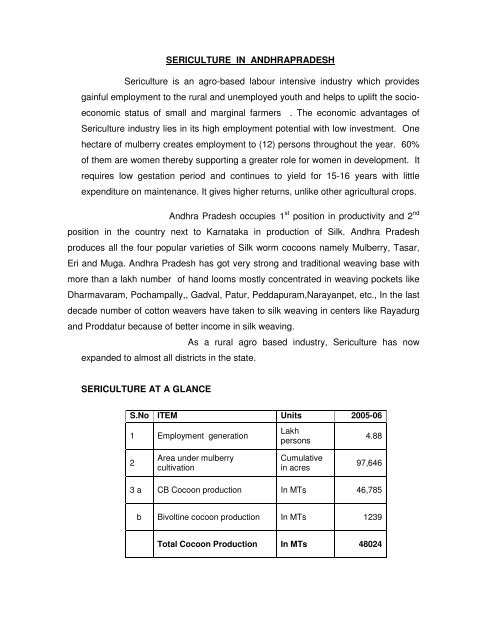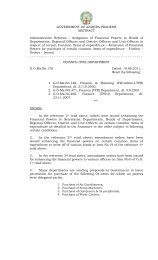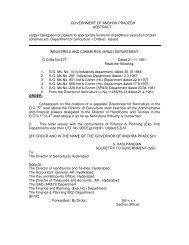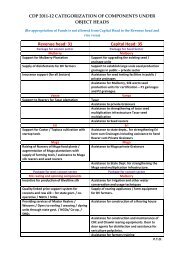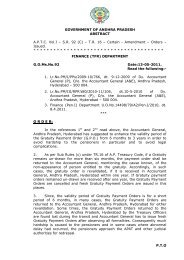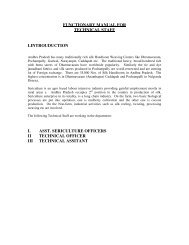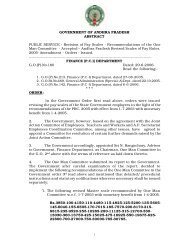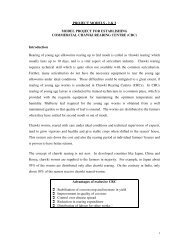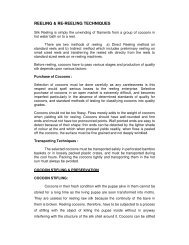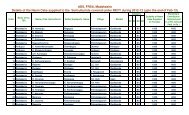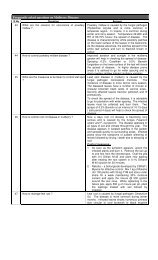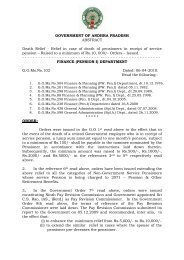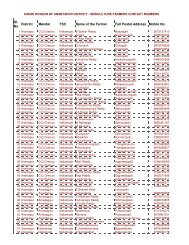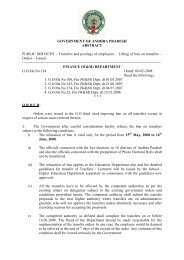SERICULTURE IN ANDHRAPRADESH Sericulture ... - Seri.ap.gov.in
SERICULTURE IN ANDHRAPRADESH Sericulture ... - Seri.ap.gov.in
SERICULTURE IN ANDHRAPRADESH Sericulture ... - Seri.ap.gov.in
- No tags were found...
Create successful ePaper yourself
Turn your PDF publications into a flip-book with our unique Google optimized e-Paper software.
<strong>SERICULTURE</strong> <strong>IN</strong> <strong>ANDHRAPRADESH</strong><strong><strong>Seri</strong>culture</strong> is an agro-based labour <strong>in</strong>tensive <strong>in</strong>dustry which providesga<strong>in</strong>ful employment to the rural and unemployed youth and helps to uplift the socioeconomicstatus of small and marg<strong>in</strong>al farmers . The economic advantages of<strong><strong>Seri</strong>culture</strong> <strong>in</strong>dustry lies <strong>in</strong> its high employment potential with low <strong>in</strong>vestment. Onehectare of mulberry creates employment to (12) persons throughout the year. 60%of them are women thereby support<strong>in</strong>g a greater role for women <strong>in</strong> development. Itrequires low gestation period and cont<strong>in</strong>ues to yield for 15-16 years with littleexpenditure on ma<strong>in</strong>tenance. It gives higher returns, unlike other agricultural crops.Andhra Pradesh occupies 1 st position <strong>in</strong> productivity and 2 ndposition <strong>in</strong> the country next to Karnataka <strong>in</strong> production of Silk. Andhra Pradeshproduces all the four popular varieties of Silk worm cocoons namely Mulberry, Tasar,Eri and Muga. Andhra Pradesh has got very strong and traditional weav<strong>in</strong>g base withmore than a lakh number of hand looms mostly concentrated <strong>in</strong> weav<strong>in</strong>g pockets likeDharmavaram, Pochampally,, Gadval, Patur, Pedd<strong>ap</strong>uram,Narayanpet, etc., In the lastdecade number of cotton weavers have taken to silk weav<strong>in</strong>g <strong>in</strong> centers like Rayadurgand Proddatur because of better <strong>in</strong>come <strong>in</strong> silk weav<strong>in</strong>g.As a rural agro based <strong>in</strong>dustry, <strong><strong>Seri</strong>culture</strong> has nowexpanded to almost all districts <strong>in</strong> the state.<strong>SERICULTURE</strong> AT A GLANCES.No ITEM Units 2005-061 Employment generationLakhpersons4.882Area under mulberrycultivationCumulative<strong>in</strong> acres97,6463 a CB Cocoon production In MTs 46,785b Bivolt<strong>in</strong>e cocoon production In MTs 1239Total Cocoon Production In MTs 48024
4 Cocoon production / 100 Dfls In Kgs 54.45 Raw silk production In MTs 5,3366 <strong><strong>Seri</strong>culture</strong> farmers In Nos 76,9717Tasar food plantation Availablefor rear<strong>in</strong>gIn acres 250008 Tasar Dfls brushed Lakh nos. 8.829 Tasar Cocoon production Lakh nos. 113.5310 Tasar rearers (In No.s). 3,00011 Area under Castor& TopiocaIn lakhHectares3.7412 Eri Dfls brushed (In No.s). 1.75913 Eri cocoon production MTs 33.500OBJECTIVES OF THE DEPARTMENT OF <strong>SERICULTURE</strong> DUR<strong>IN</strong>G 2006-07 : To stabilize the exist<strong>in</strong>g area under mulberry and br<strong>in</strong>g an additional area of8700 acres under mulberry cultivation with High Yield<strong>in</strong>g Varieties. To produce 51415 tonnes of reel<strong>in</strong>g cocoons. To produce and supply quality Cross Breed Disease Free lay<strong>in</strong>gs throughDepartmental Gra<strong>in</strong>ages. To <strong>in</strong>crease productivity at the farmer level to 55 Kgs per 100 dfls. To generate employment to 4.35 lakh persons both directly and <strong>in</strong>directly. To produce and supply quality Tasar lay<strong>in</strong>gs to 3,000 rearers who are mostlyTribals. To produce 2400 M.Tonnes of bivolt<strong>in</strong>e cocoons for the production of Globallycompetitive Internationally graded Silk required to face the challenges of W.T.O. To improve productivity levels <strong>in</strong> Tasar culture
Expansion of Ericulture to the potential districts of Telangana and Coastalareas where castor and t<strong>ap</strong>ioca are abundantly grown .Ericulture is also be<strong>in</strong>g<strong>in</strong>troduced on pilot basis <strong>in</strong> perennially drought affected district of Anant<strong>ap</strong>ur. To implement Economical water management system through Drip Irrigation.To dissem<strong>in</strong>ate Scientific <strong>Seri</strong>cultural Practices by promot<strong>in</strong>g modernizationand quality up gradation of the <strong>in</strong>dustry. To develop of Region specific & season specific races through APSSRDI,H<strong>in</strong>dupur. To <strong>in</strong>tegrate of Non Farm Activities ie. Reel<strong>in</strong>g and Twist<strong>in</strong>g with weav<strong>in</strong>g andto strengthen l<strong>in</strong>kages between the farm and non farm activities.STRATEGIES OF THE DEPARTMENT :Though the present production of cocoons per unit area ismore remunerative when compared to the other commercial crops, this may nothelp for the sustenance of the <strong>in</strong>dustry <strong>in</strong> the long run. Therefore, it is imperative to<strong>in</strong>crease the productivity levels on par with sericulturally advanced countries. Thedepartment has identified certa<strong>in</strong> g<strong>ap</strong>s, which are com<strong>in</strong>g <strong>in</strong> the way of produc<strong>in</strong>gqualitative and quantitative production of cocoons.ON-FARM SECTOR: Expansion of mulberry with High Yield<strong>in</strong>g Varieties. Ma<strong>in</strong>tenance of Separate Chawkie Gardens( for young age silk wormrear<strong>in</strong>g to reduce mortality). Effective Water Management like “Drip Irrigation”. Appropriate Dis<strong>in</strong>fection Technology. Separate pucca rear<strong>in</strong>g house. Shoot harvest<strong>in</strong>g and Shelf rear<strong>in</strong>g. Rotary Mountages. Human Resource Development. Research & Development. Special thrust for promotion of Bivolt<strong>in</strong>e Hybrid cocoons & Production ofInternational grade silk.
NON-FARM SECTOR:Inspite of all out efforts be<strong>in</strong>g made to modernize the <strong>in</strong>dustry thepost cocoon activities especially reel<strong>in</strong>g activity is not emerg<strong>in</strong>g as economicallyviable due to high <strong>in</strong>vestment with low profit marg<strong>in</strong>. As a result, most of thecocoons produced <strong>in</strong> the State are mak<strong>in</strong>g way to the neighbor<strong>in</strong>g states. Thestrategies adopted for non-farm sector development are Work<strong>in</strong>g c<strong>ap</strong>ital assistance to the non-farm sector units. Entrepreneur Development Programs Assistance for establish<strong>in</strong>g silk reel<strong>in</strong>g, twist<strong>in</strong>g, looms, process<strong>in</strong>g units. Review of silk import policy Sett<strong>in</strong>g up of improved multiend reel<strong>in</strong>g mach<strong>in</strong>es Provid<strong>in</strong>g of <strong>in</strong>terest subsidy on loans & work<strong>in</strong>g c<strong>ap</strong>ital for the reelershav<strong>in</strong>g cottage and Multiend bas<strong>in</strong>s to reduce the <strong>in</strong>terest burden to theentrepreneurs. Computerized l<strong>in</strong>k<strong>in</strong>g of all the Cocoon Markets <strong>in</strong> the State to know the<strong>in</strong>formation on Market rates both for rearers & reelersThe Department has planned to revive 204 Silk Reel<strong>in</strong>g bas<strong>in</strong>swith the annual production c<strong>ap</strong>acity of 42 MTs from the exist<strong>in</strong>g level of 70 bas<strong>in</strong>swith 14 M.tonnes. It is also planned to establish the required number of bas<strong>in</strong>s andsp<strong>in</strong>dles to consume the entire quantity of cocoons that would be produced <strong>in</strong> <strong>ap</strong>hased manner.DEPARTMENTAL <strong>IN</strong>FRASTRUCTURE :The available technical <strong>in</strong>frastructure details is as follows:S.No. Name of the UnitNumberof Units01 On Farm Technical Service Centers 14002 Seed farms 3903 Seed area TSCs 904 Seed Cocoon Markets 405 Gra<strong>in</strong>ages 1306 Govt. Cocoon Markets 807 Reel<strong>in</strong>g units 1508 Non-farm TSCs 11
09 Tra<strong>in</strong><strong>in</strong>g Centres / Units 810 Tasar seed stations 9PROGRESS DUR<strong>IN</strong>G 2005-06 : A quantity of 1239 MTs of Bivolt<strong>in</strong>e cocoons was produced forthe first time <strong>in</strong> the state by dovetail<strong>in</strong>g all associated facilitieslike rear<strong>in</strong>g sheds , rear<strong>in</strong>g equipment and drip irrigation systemetc., to the Bivolt<strong>in</strong>e farmers. 1595 separate rear<strong>in</strong>g sheds have been constructed. So far atotal of 10099 separate sheds were constructed under CatalyticDevelopment programme for the benefit of farmers and to<strong>in</strong>crease bivolt<strong>in</strong>e sericulture. An extent of 1462 acres has been covered under the DripIrrigation programme . An extent of 7834 acres of new area has been covered undermulberry. Bivolt<strong>in</strong>e Silk Worm eggs supplied to Bivolt<strong>in</strong>e farmers onsubsidized cost @ Rs. 100/- per 100 Disease free lay<strong>in</strong>gs 3,000 tribal families are engaged <strong>in</strong> rear<strong>in</strong>g of Tasar silk wormson the food plants available <strong>in</strong> the forest areas of Adilabad,Karimnagar , Warangal and Khammam Districts and produced aquantity of 113.535 Lakh number of tasar cocoons. The Department <strong>in</strong> co-ord<strong>in</strong>ation with the Central Silk Boardunder Catalytical Developmental Programme is implement<strong>in</strong>g anEri Project to create an additional <strong>in</strong>come to Castor/Topiocagrowers through rear<strong>in</strong>g of Eri silkworms <strong>in</strong> Nalgonda,Mahabubnagar and East Godavari districts. A quantity of 33.50 Metric tonnes of Eri cocoons was producedby 811 Castor and T<strong>ap</strong>ioca farmers which is a record . Ericultureis provid<strong>in</strong>g additional <strong>in</strong>come to farmers. Special programmes such as Mass Dis<strong>in</strong>fection Programme,Tra<strong>in</strong><strong>in</strong>g programme etc., are be<strong>in</strong>g implemented for the benefit ofsmall, marg<strong>in</strong>al farmers, Reelers, Scheduled Castes, ScheduledTribes and Women to enable them to <strong>in</strong>crease the productivity andtheir economic status.
To encourage the Private reelers and to strengthen Non FarmSector , schemes like Production <strong>in</strong>centive to Multiend reel<strong>in</strong>gunits on Production of Quality Silk Yarn , Interest subsidy onloans and work<strong>in</strong>g c<strong>ap</strong>ital for the reel<strong>in</strong>g units sanctioned byCommercial Banks are be<strong>in</strong>g implemented . Production <strong>in</strong>centiveto 21946 Kgs of Multivolt<strong>in</strong>e and 12974 Kgs of Bivolt<strong>in</strong>e Silk hasbeen provided to the reelers. Provid<strong>in</strong>g assistance to the drought affected farmers for revivalof mulberry.NEW <strong>IN</strong>ITIATIVES OF THE DEPARTMENT :• 16 Multiend reel<strong>in</strong>g units were revived under private sector .In addition tothis 15 Govt. Silk Reel<strong>in</strong>g units were also revived <strong>in</strong> the State for effectiveutilization of the services of the workers and to help the farmers <strong>in</strong> sell<strong>in</strong>gtheir cocoons at competitive prices.• To encourage post cocoon activity and to bridge the g<strong>ap</strong> between the onfarm and non farm sectors to maximum extent , it is proposed to establishone Ch<strong>in</strong>ese automatic reel<strong>in</strong>g unit under private sector.• To provide market<strong>in</strong>g facility to the ERI farmers , it is proposed toestablish one ERI process<strong>in</strong>g cum sp<strong>in</strong>n<strong>in</strong>g unit under private sector.• Expansion of Tasar and Ericulture to other potential Districts <strong>in</strong> the State.FOCUSSED AREAS:SEED PRODUCTION:A systematic 3 tier system of seed organization programme has beenestablished i.e., at P3, P2 and P1 level multiplication for both local and foreignraces, to supply quality seed cocoons for production and supply of disease freesilkworm eggs to the farmers. The State has achieved self sufficiency <strong>in</strong> theproduction of seed cocoons for the production of disease free silkworm eggs <strong>in</strong>Government gra<strong>in</strong>ages. Adequate <strong>in</strong>frastructure with support<strong>in</strong>g staff is available forsmooth function<strong>in</strong>g of seed organization.EXTENSION SUPPORT:The Department is advocat<strong>in</strong>g new technologies <strong>in</strong> both Mulberry cultivationand silkworm rear<strong>in</strong>g to the farmers through Technical Service Centres <strong>in</strong> order to
<strong>in</strong>crease cocoon production <strong>in</strong> the State and to <strong>in</strong>crease productivity per acre.Study tours are regularly organized and extension literature on latest techniques isdistributed regularly.. Mobile Farmers Tra<strong>in</strong><strong>in</strong>g Units are also <strong>in</strong>volv<strong>in</strong>g <strong>in</strong> transferof new technologies to all <strong><strong>Seri</strong>culture</strong> villages. Average productivity per 100 DFLs<strong>in</strong> several areas of the State has reached 54.40 Kgs.Promotion of High Yield<strong>in</strong>g Variety Mulberry plantation:The ma<strong>in</strong> focus will be to <strong>in</strong>crease the productivity and thereby the <strong>in</strong>comeper unit area. In order to <strong>in</strong>crease the productivity of leaf yield, major thrust hasbeen given to <strong>in</strong>crease the area under high yield<strong>in</strong>g varieties of mulberry s<strong>ap</strong>l<strong>in</strong>gswith wider spac<strong>in</strong>g.The farmers have realised the importance of quality consciousness ofmulberry leaf varieties and are voluntarily com<strong>in</strong>g forward to take up V1 & S-seriesvariety of plantation through s<strong>ap</strong>l<strong>in</strong>gs with wider spac<strong>in</strong>g and also paired rowsystem. The farmers are replac<strong>in</strong>g the exist<strong>in</strong>g mulberry varieties with V1& S-series<strong>in</strong> a phased manner.Rais<strong>in</strong>g of Kissan Nurseries:Tak<strong>in</strong>g <strong>in</strong>to consideration of the grow<strong>in</strong>g demand for V1 MulberryPlantations, the farmers are be<strong>in</strong>g encouraged to take up Kissan nurseries oncommercial l<strong>in</strong>es to meet the demand of the farmers for s<strong>ap</strong>l<strong>in</strong>gs. It is alreadyproved as a viable commercial proposition and the farmers are rais<strong>in</strong>g nurseriestwice <strong>in</strong> a year dur<strong>in</strong>g February and July. Plantation through S<strong>ap</strong>l<strong>in</strong>gs have manyadvantages over plantation through cutt<strong>in</strong>gsAdvantages of s<strong>ap</strong>l<strong>in</strong>gs:• High survival rate due to exist<strong>in</strong>g root system.• Higher area coverage due to better use of plant material.• Scope for removal of undesirable variety at nursery stage.• Quick and better establishment of garden.• Plants can be tra<strong>in</strong>ed suitably.• Uniform development of the garden.• S<strong>ap</strong>l<strong>in</strong>gs can be raised <strong>in</strong> time to take up timely plantation dur<strong>in</strong>g monsoon.• M<strong>in</strong>imum of (3) crops can be taken dur<strong>in</strong>g the 1 st year of establishment.
Promotion of Drip Irrigation:As a water conservative measure, much impetus is be<strong>in</strong>g given for Drip irrigationwhich is proved as most effective <strong>in</strong> economic use of water for irrigation and is wellsuited for mulberry plants. The f<strong>in</strong>ancial assistance available to the farmersthrough the Centrally Sponsored CDP Scheme of CSB is effectively utilised for thepromotion of large scale adoption of this technology at the ground level.Adoption of more crop cycles per year:The farmers are divid<strong>in</strong>g their mulberry gardens <strong>in</strong> to two plots and areharvest<strong>in</strong>g 8-10 crop cycles per annum. By this the farmers are able to get <strong>in</strong>comealmost every month thereby improv<strong>in</strong>g their economic status.Promotion of Bivolt<strong>in</strong>e Rear<strong>in</strong>g Technology:Realiz<strong>in</strong>g the importance of quality and productivity for sustenance ofsericulture <strong>in</strong>dustry , the department has formulated a massive Bivolt<strong>in</strong>eProgramme <strong>in</strong> the State by identify<strong>in</strong>g nucleus villages and propagat<strong>in</strong>g Bivolt<strong>in</strong>eTechnology. This could be achieved only by provid<strong>in</strong>g <strong>in</strong>centives to the Bivolt<strong>in</strong>efarmers for construction of Rear<strong>in</strong>g Sheds, Rear<strong>in</strong>g Equipments, Drip irrigationfacility, supply of dis<strong>in</strong>fectants etc,. By creat<strong>in</strong>g the above associated facilities, thefarmers are able to improve their productivity and are produc<strong>in</strong>g quality Bivolt<strong>in</strong>eSilk of International Grade.BIVOLT<strong>IN</strong>E HYBRID PROGRAMME <strong>IN</strong> ANDHRA PRADESH:The Department is implement<strong>in</strong>g Bivolt<strong>in</strong>e hybrid programme throughoutAndhra Pradesh with the f<strong>in</strong>ancial assistance of Central Silk Board & Governmentof Andhra Pradesh. A record production of 1239 M.T of bivot<strong>in</strong>e cocoons wasachieved dur<strong>in</strong>g 2005-06Promotion of Chawkie Rear<strong>in</strong>g Centres (CRCs):The farmers have conceived the concept of supply of chawkie worms as acommercial proposition <strong>in</strong> view of the great acceptance for rear<strong>in</strong>g of wormssupplied through chawkie which reduces the period of rear<strong>in</strong>g at farmers level withassured <strong>in</strong>crease <strong>in</strong> productivity.
The farmers are com<strong>in</strong>g forward to run chawkie rear<strong>in</strong>g centres <strong>in</strong> privatesector voluntarily. The f<strong>in</strong>ancial assistance available under CDP is be<strong>in</strong>g effectivelyutilised by such farmers who are will<strong>in</strong>g to construct chawkie rear<strong>in</strong>g build<strong>in</strong>gs andpurchase the chawkie rear<strong>in</strong>g equipments.MARKET<strong>IN</strong>G FACILITIES TO THE FARMERS:Market<strong>in</strong>g facility to the cocoons produced by the farmers is providedthrough (8) regulated Cocoon Markets and (16) Notified Markets . To ensure areasonable price to the farmers, cocoon test<strong>in</strong>g procedure was <strong>in</strong>troduced <strong>in</strong> all theCocoon Markets which is found to be more beneficial to the farmers. This will<strong>in</strong>duce quality consciousness among farmers and reelers. For the benefit offarmers and reelers, Information Centers have been established <strong>in</strong> the CocoonMarkets to depict various improved technologies ma<strong>in</strong>ly through audiovisual Aids.Cocoon Market rates are be<strong>in</strong>g broadcasted daily through All India Radio andpopular T.V channels. They are published <strong>in</strong> News p<strong>ap</strong>ers also. For the benefit ofthe farmers <strong>in</strong>formation on market rates also kept on the <strong><strong>Seri</strong>culture</strong> Web site.SILK REEL<strong>IN</strong>G:Though <strong><strong>Seri</strong>culture</strong> has been develop<strong>in</strong>g very r<strong>ap</strong>idly <strong>in</strong> respect of cocoonproduction <strong>in</strong> the State, reel<strong>in</strong>g activities are yet to be developed at the same pace.There is still a wide g<strong>ap</strong> between the production of cocoon and consumption with <strong>in</strong>the State.(11) Non-Farm Technical Service Centers have been set up for the exclusivepromotion of post cocoon activity as there is good potential for the development ofNon-Farm sector domestically.<strong>IN</strong>CENTIVES TO THE REEL<strong>IN</strong>G <strong>IN</strong>DUSTRY:1. An <strong>in</strong>centive of Rs.100/- per kg. of silk is be<strong>in</strong>g given to the Reelersunder CDP programme to encourage Bivolt<strong>in</strong>e Silk Production onMultiend Silk Reel<strong>in</strong>g Units2. An <strong>in</strong>centive of Rs.50/- per kg for the production of Multivolt<strong>in</strong>e Silkreeled on Multiend Silk Reel<strong>in</strong>g Units which is suitable for warp is alsobe<strong>in</strong>g given to reelers under SDF.
3. Department is provid<strong>in</strong>g Skill up-gradation tra<strong>in</strong><strong>in</strong>g programme to theworkers of Improved Multi-end Silk Reel<strong>in</strong>g units on stipendiary basis<strong>in</strong>clud<strong>in</strong>g 25% cost of raw material .4. Subsidy to the maximum of 50% on work<strong>in</strong>g c<strong>ap</strong>ital loan will be paid tothe f<strong>in</strong>ancial <strong>in</strong>stitutions by the Department on behalf of silk reelers tom<strong>in</strong>imize the burden on small and marg<strong>in</strong>al silk reelers to encourage andalso for sustenance of non-farm units.5. 50% Subsidy on mach<strong>in</strong>ery cost is proposed to be provided besides100% subsidy on CST and Transportation charges, where the traditionalcharka silk reel<strong>in</strong>g bas<strong>in</strong>s are be<strong>in</strong>g replaced with Improved CottageBas<strong>in</strong> Silk Reel<strong>in</strong>g bas<strong>in</strong>s .6. Assistance is be<strong>in</strong>g extended for establishment of Improved Multi-endSilk Reel<strong>in</strong>g units (15:35:50) by DoS-AP, CSB and beneficiaryrespectively on the unit cost of 6, 10 and 20 bas<strong>in</strong> Improved Multi-endSilk Reel<strong>in</strong>g Units.7. Special package of scheme is also be<strong>in</strong>g implemented for payment ofRs.75/- per kg of Multi-volt<strong>in</strong>e (Yellow) and Rs.125/- per kg of Bivolt<strong>in</strong>e(White) silk as production <strong>in</strong>centive <strong>in</strong> non-traditional districts ofHyderabad and E.Godavari / W.Godavari / Krishna as “Incentive forproduction of quality raw silk on Improved Multi-end Silk reel<strong>in</strong>g Units.”8. 50% subsidy is be<strong>in</strong>g given to the progressive multi-end silk reelers onthe cost of plant/mach<strong>in</strong>ery to establish reel<strong>in</strong>g accessories likepressurized cocoon cook<strong>in</strong>g system / water softeners / boilers forproduction of quality raw silk under the scheme “Assistance forpurchase of accessories for Improved Multi-end silk reel<strong>in</strong>g mach<strong>in</strong>ery”.9. For consumption of defective reel<strong>in</strong>g cocoons and to encourage small silkreelers, who can not afford for Improved multi-end silk reel<strong>in</strong>g mach<strong>in</strong>ery,which is more expensive, necessary assistance to establish ImprovedCottage Bas<strong>in</strong> / Motorized Charka / Dupion Charka reel<strong>in</strong>g mach<strong>in</strong>ery isbe<strong>in</strong>g provided under CDP.TASSAR SECTOR:An extent of 8400 hectares of Tasar food plants are available forconduct of Tasar silk worm rear<strong>in</strong>g <strong>in</strong> the forest. 3000 Nos. of Tasar
earers who are mostly tribals are engaged <strong>in</strong> Tasar silk Worm rear<strong>in</strong>g.Dur<strong>in</strong>g 2005-06 a quantity of 113.535 lakh numbers of Tasar cocoonswas produced by implementation of CDP schemes under Tasar sector.ERICULTURE PROJECT:The Department is implement<strong>in</strong>g Eri Project to create additional <strong>in</strong>come ofRs 3000/- to Rs 4000/- per acre to Castor / Topioca growers through rear<strong>in</strong>g of EriSilkworms. The Project is be<strong>in</strong>g implemented on pilot basis <strong>in</strong> Nalgonda,Mahabubnagar and East Godavari districts <strong>in</strong> co-ord<strong>in</strong>ation with the Central SilkBoard . A quantity of 33.50 tones of Eri cocoons was produced dur<strong>in</strong>g 2005-06. Itis planned to expand the programme to Ranga Reddy, Medak, Nizamabad,Prakasam, Srikakulam, Vizianagaram & Visakh<strong>ap</strong>atnam Districts.RESEARCH AND DEVELOPMENT:Andhra Pradesh State <strong><strong>Seri</strong>culture</strong> Research & Development Institute hasbeen set up as an autonomous organisation <strong>in</strong> Andhra Pradesh at Kerikera villagenear H<strong>in</strong>dupur <strong>in</strong> Anant<strong>ap</strong>ur District to cater to the research needs of the State. Thema<strong>in</strong> objective of this <strong>in</strong>stitute is to carry out research on all aspects of <strong><strong>Seri</strong>culture</strong>with a special emphasis on ad<strong>ap</strong>tive research and to develop region specific, andseason specific silkworm breeds. The Research work on ma<strong>in</strong>tenance of breed<strong>in</strong>gstock, purification and isolation of <strong>in</strong>breed<strong>in</strong>g are under progress. Test<strong>in</strong>g of severalBi-volt<strong>in</strong>e hybrid comb<strong>in</strong>ations at different regions is under progress. A new Multi XBi-volt<strong>in</strong>e hybrid namely “SWARNANDHRA” has been successfully released by APState <strong><strong>Seri</strong>culture</strong> Research & Development Institute, H<strong>in</strong>dupur. Similarly two newBivolt<strong>in</strong>e hybrids, namely “HEMAVATHI” and “KALPATHARUVU” have also beenreleased and these races have resulted <strong>in</strong> <strong>in</strong>creased output of white cocoons,which have been found to be suitable to produce silk yarn of <strong>in</strong>ternational grade. Inaddition (4) Races which are suitable to Andhra Pradesh are also under pipe l<strong>in</strong>efor release.


